How To Go From Jazz Newbie To Gigging In Less Than 2 Years
Not accomplishing your musical goals fast enough? Feel blocked? Wish you could accomplish bigger things with jazz?
Model the 7 strategies Jazz Inner Circle member Greg used to go from jazz newbie to gigging pianist in less than 2 years. Watch this video now. I’ll teach you all 7 steps.
If you want help getting past your own musical limitations you can apply for The Jazz Inner Circle Program right here.
Greg’s 7 Steps To Jazz Piano Success
Would you to transform your own playing too? You’re in the right place. Watch the video above and follow the same path.
Video Transcript
 A lot of people have been asking me recently about my student, Greg.
A lot of people have been asking me recently about my student, Greg.
He’s the one who entered my Jazz Inner Circle Program as a jazz piano beginner and in less than 2 years went from a complete jazz newbie to gigging and having a ton of musical opportunities, lots of gigs, lots of jam session opportunities, no shortage of cool things to do with music.
Today what I wanted to do is I wanted to actually break down the strategies. There were 7 core strategies that Greg and I used to get him from newbie to gigging in less than 2 years. It’s really cool.
Let’s break down the techniques that Greg and I used right now so you can get a lot of benefit out of exploring them.
There are 7 core fundamental techniques that we used, and if you do the same I promise you will get great results as well. So, let’s dig in:
1. How To Set A Crystal Clear Goal
 The very first thing that Greg did (and this is something that frankly the vast majority of students trying to learn this art form fail to do) was Greg set a very crystal clear vision of where he wanted to go.
The very first thing that Greg did (and this is something that frankly the vast majority of students trying to learn this art form fail to do) was Greg set a very crystal clear vision of where he wanted to go.
Now, most people — you know, as I’m talking here, this may remind you of yourself — when they’re learning jazz or learning anything musically, they sort of do it in a very haphazard way.
One day they practice this. The next day they practice this. A friend of theirs mentions this. They buy this book and they’re on to the next topic.
Every day and every week and every month, you’re moving from topic to topic, and it causes a lot of stress because at the end of the day you’re not really accomplishing much musically.
It feels horrible when you’re practicing, and you’re really not accomplishing the true vision that you have for yourself.
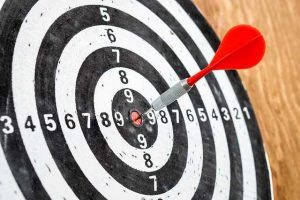 Greg knew that he wasn’t going to make this absolute newbie mistake and just sort of jump around like crazy.
Greg knew that he wasn’t going to make this absolute newbie mistake and just sort of jump around like crazy.
He knew that if he wanted to get where he wanted to be, his gigging goal, he had to set a crystal clear vision for himself and make sure that there was a crystal clear path to get there: the path toward gigging.
He wanted the opportunity to play solo piano and to be able to say yes when a gig came his way in an ensemble situation.
He wanted to play with other musicians at jam sessions, be able to play in bands, and just have fun.
To be able to gig is an incredible feeling when you’re up there on stage, and he wanted that feeling. It was clear to him, and this was the goal he set forth for himself. So, that was the very first step.
In your case, set a clear goal for yourself.
2. How Being Honest To Yourself Helps You Go Pro
 The second thing that Greg did was he was honest with himself. He said, “Listen, I don’t know how to get where I want to go.” In his case, it was a gigging thing, and he had never really done a lot of gigging in the past.
The second thing that Greg did was he was honest with himself. He said, “Listen, I don’t know how to get where I want to go.” In his case, it was a gigging thing, and he had never really done a lot of gigging in the past.
He wasn’t really sure how to fully arrange tunes. How does a solo piano player go out and perform? How do they play the intros? The outros? The repertoire? How do they voice their chords? How do they keep the rhythm? How do they keep the audiences entertained? He didn’t know how to do it.
Now, he didn’t beat himself up about it. He just was honest.
He said, “Listen, I don’t know how to do it. I don’t know how to adjust my playing when I’m playing in a rock band — You know, how do I adjust from a rock band to a jazz situation? How do I be a lead player if I’m in a trio? How do I improvise over the tunes?”
He just wasn’t really clear. He knew he wanted to be able to do it, but he was honest. He knew that he couldn’t do this stuff where he was at now, and he knew he needed help.
3. Why Finding A Mentor Can Help You Learn Faster
 So, the second thing he did was he went and found a mentor. He didn’t try to go this journey by himself.
So, the second thing he did was he went and found a mentor. He didn’t try to go this journey by himself.
He sought out someone who had been through the path before, had essentially been successful (and extremely successful in that path), and he sought their advice.
And he was smart: he worked with somebody who knew exactly what he was doing.
So that’s the second component: working with a mentor.
Now, once Greg and I got together (and I’m always pleased to work with talented, bright, motivated students), he told me where he wanted to be, and again he mentioned his gigging goal.
I said, “Great! Let’s break down all the elements we need to accomplish those goals.” This is what I did to book 1,700 gigs throughout my career, and we broke things down step by step.
4. What You Should Know About Playing Solo Piano Gigs
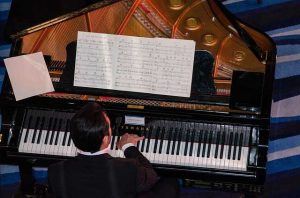 So, from the solo piano perspective, I wanted to make sure that he had a repertoire. And this is really the starting point for playing gigs: It’s having a great repertoire.
So, from the solo piano perspective, I wanted to make sure that he had a repertoire. And this is really the starting point for playing gigs: It’s having a great repertoire.
He didn’t have to be Oscar Peterson.
You know, a lot of people worry like, “Oh man! You know, if I don’t sound like Keith Jarrett or I don’t sound like Hiromi or Oscar then I can’t play solo piano gigs.” That’s not true at all.
You can still play really professional solo piano gigs. You don’t have to be all over the keyboard. You just have to play really great arrangements with great voicings, great rhythms, intros, outros to keep people entertained.
So that was the first thing we worked on was the solo piano aspects of his playing.
We built out a whole repertoire so when those gig opportunities came (and they did eventually come quite abundantly), we wanted to make sure that he was fully prepared for that.
That was the first component that Greg and I worked on.
We worked on that system to make sure that he could essentially learn tunes very quickly, but not in a haphazard way, not in a way that sounded kind of cheesy, that sounded professional, robust, and was frankly real jazz piano.
So, that was the first thing that him and I did when we worked together.
5. How To Learn Performing With An Ensemble
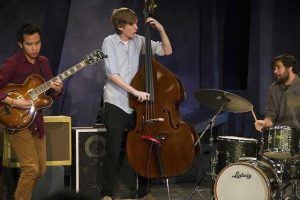 Now, the second thing he did was we knew that he wanted to play in an ensemble, and he wanted to be the lead instrument like as if he was playing with a trio (and there was a drummer and bass accompanying him).
Now, the second thing he did was we knew that he wanted to play in an ensemble, and he wanted to be the lead instrument like as if he was playing with a trio (and there was a drummer and bass accompanying him).
We also knew that he wanted to essentially accompany other people (play behind other musicians).
From the trio perspective, what we did was we really worked on how do you arrange tunes in a trio format? What voicings do you use? What rhythms do you use? What registers of the piano? How do you keep tunes interesting? How do you keep audiences engaged?
So we did a really deep dive into the arranging techniques of people like Bill Evans, Chick Corea, Wynton Kelly.
We even explored Bud Powell and Barry Harris’s playing as well and take a look at how they handled trio playing. So we dove into that and we built him a repertoire as well that he could and play in a trio setting.
Now, if you’re listening right now and you’re saying, “Well, listen. You know, Steve, what do you mean by a trio?”
 Basically, when you go to a jam session or if you’re the lead instrument in any type of musical situation as a piano player, you’re going to be expected to be able to play a melody and accompany yourself and adjust your playing with drums and bass behind you.
Basically, when you go to a jam session or if you’re the lead instrument in any type of musical situation as a piano player, you’re going to be expected to be able to play a melody and accompany yourself and adjust your playing with drums and bass behind you.
It’s a critically important way to play.
For example, if I was the lead artist and I had people accompanying me, it would be like the Steve Nixon trio, and I’d have bass and drums behind me.
I would be playing the melodies and playing the harmonies and the bass and drums would be accompanying me. It’s a really important skill that you learn how to do that. Otherwise, you’re going to embarrass yourself on stage.
So that was the second component we worked on.
Now, the next component we worked on (and this is something that a lot of students struggle with) is that, you know, okay cool, they learn some arranging techniques and they finally get something together
But when it comes time to truly improvise and take a solo on a tune, they fall flat on their face.
It’s a low point in the music. And you know, Greg really wanted to shine when it came to improvisation. And he has come a long way. I love the way that he improvises now.
6. How To Learn Killer Improv Skills
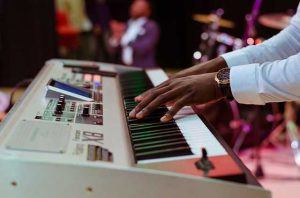 So, he knew that he needed to improvise. We sat down and we worked on improvisation techniques.
So, he knew that he needed to improvise. We sat down and we worked on improvisation techniques.
We explored bebop improvisational concepts, things like playing with chord tones, enclosure patterns, minor line cliches, all the elements that will make up a great killer melodic swinging improvisation.
We looked at modal improvisation techniques. We looked at bluesy techniques, chordal stuff, the type of stuff that George Shearing would do with two-handed block chords.
We looked at all these different devices so he’d have all these different ways of expressing himself.
So, it wasn’t a low point in the music like a lot of people would have where they’re spiritually and emotionally disconnected when it comes time to take a solo, and they’re embarrassed.
We wanted it to be a high point where he could express himself and do great things on tunes, so we really dug deep into those improvisational concepts. So that was the next thing we worked on.
7. How To Comp Like A Master
 And lastly, at this point — Greg — he plays with a lot of other musicians.
And lastly, at this point — Greg — he plays with a lot of other musicians.
He’s playing in trio settings and he’s going to jam sessions and working in a variety of different settings.
You know, there are times as piano players where we’re backing up other musicians, whether that be accompanying a singer (which is a very, very common gig for a piano player to have), if you sing accompanying yourself, accompanying a sax player or some other lead instrument, a guitar player soloing on top, right? Something where you are playing in the background and you’re supporting it.
If you’re playing in a trio, and the bass player is soloing, you’re laying down chords and rhythms in a complementary way behind that. You need to know how to do that as well.
So, that was the other thing that we worked on, and there’s a very specific rhythmic and voicing structure that you have to know in order to do that stuff.
You know, a lot of people make the horrible mistake of doing all the solo piano stuff or all just the trio voicings they do when they’re comping behind other people, and that’s a real quick way to upset the other musicians you play with.
You have to make sure that you’re being supportive and complementary, driving the band forward, making other people sound good. And it’s sort of like going into a restaurant. You know, do you ever see those signs that say “No shirt, no shoes, no service”, right?
Like most people know you shouldn’t go into a restaurant without a shirt and shoes, and that’s almost the equivalent of going into a jam session playing with other people without a shirt or shoes on if you play the wrong types of voicings and rhythms.
You need to know the culture. You need to know the style, and you need to know how to fit in and make people feel great.
How To Put These 7 Core Strategies Into Action
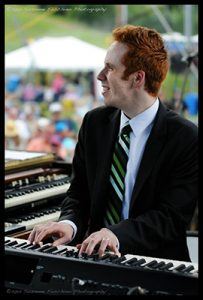 So, if this sounds cool to you and you wish you had somebody to walk you through step by step and help you accomplish your musical goals, we have a program that’s designed specifically for that reason.
So, if this sounds cool to you and you wish you had somebody to walk you through step by step and help you accomplish your musical goals, we have a program that’s designed specifically for that reason.
It’s called the Jazz Inner Circle program, and this is the program that Greg participated in.
If you wish you had a jazz and blues piano mentor to take you step-by-step through this process to help you accomplish all of your own personal goals too, I would highly encourage you to apply for this program.
You can go to https://www.freejazzlessons.com/inner-circle, fill out an application there, and we truly look forward to helping you achieve your musical goals, and taking you through the step-by-step process, the same process like Greg, but also personalizing it toward you as well to accomplish everything you want to accomplish with your musical talent.
All right. Thank you again for listening. I look forward to seeing your application in. Again, go to https://www.freejazzlessons.com/inner-circle.
Spots are very limited, but I would definitely encourage you to apply. If you’re a motivated student, you really want to take action and really make a big difference in your playing.
All right, thanks for listening and hanging out. I’ll see you at https://www.freejazzlessons.com/inner-circle.
